
HOME
INTRO
SYMBOLS
ALMANAC
ECONOMY
GEOGRAPHY
STATE MAPS
PEOPLE
FORUM
NEWS
COOL SCHOOLS
STATE QUIZ
STATE LINKS
BOOK STORE
MARKETPLACE
GUESTBOOK
CONTACT US


You may double left-click on a word on this page to retrieve its definition. Tweet Follow
Iowa State Tree
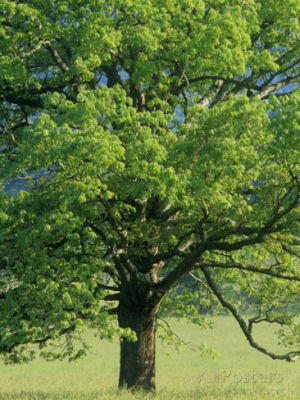
Iowa State Tree: The Oak
The tree shown is a bur oak (Quercus macrocarpa)
Photographs, prints and posters
After years of timber harvests, including clear-cutting, conservationists were looking to re-establish forest stands. A particular concern was expressed for soil erosion that followed mass harvesting of timber.
The American Association of Nurserymen, now AmericanHort, responded to citizen concern with the "Plant America" program, a movement to conserve the land, make it greener and more productive for abundant life, beauty and recreation. The effort was endorsed by federal, state and local government officials and 36 conservation groups, representing millions of members.
By 1953, 26 state governors had issued proclamations in support of the objective "to conserve the land, to make it greener and more productive, for abundant life, beauty and recreation." [1]
Recognizing that the Plant America movement needed local involvement to be successful, state committees were formed.
Within each state, the process of designating official state trees began in the early part of the 20th century and accelerated in the 1930s and 1940s.
In the 1950s, by the time the citizens of Iowa launched efforts to make the Delicious apple tree the official state tree, most states had already selected official trees to represent them.
The effort to name the apple tree as an official representative of the state did not get off the ground but interest in the idea of a state tree did not wane, particularly among garden clubs and horticultural societies within the state.
The interest in naming a state tree was heightened when a poll was conducted, under the auspices of the Iowa Horticultural Society, at the Iowa State Fair in 1958.
The poll offered eight options for the official state tree designation: basswood; black maple; black walnut; bur oak; green ash; hackberry; red oak; and white oak.
13,970 votes were recorded at the Iowa State Fair. The winning of the day was the black maple, followed by the red oak and black walnut.
- Black maple (3,094 votes)
- Red oak (2,760)
- Black walnut (2,319)
- Basswood (1,755)
- Bur oak (1,309)
- White oak (1,171)
- Hackberry (240)
- Green ash (175)
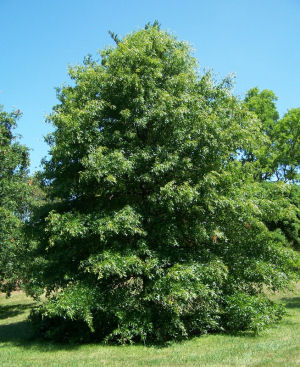
Iowa State Tree: The Oak
Photo: ©Bruce Marlin http://cirrusimage.com/
The tree shown is a pin oak (Quercus palustris)
A write-in, the pin oak received a total of 522 votes which ranked it in seventh place overall; it scored more votes than the green ash and the hackberry candidates combined. A number of other write-ins, the Delicious apple and elm tree among them, shared another 625 votes.
The results of this poll were handed over to a sub-committee of Plant Iowa headed by Afton resident, Mrs. John Young. This sub-committee was tasked with making a recommendation to the Iowa Legislature and ensuring that legislation be introduced and approved by the 1959 session.
Mrs. Young's committee solicited and received suggestions from garden clubs, horticultural societies and other interested parties from all over the state and was committed to making a recommendation that would best suit the State of Iowa. The committee's recommendation would be based on numeric scores garnered by state tree candidates in categories such as longevity, disease-resistance, economic importance, hardiness, historical importance, and area of distribution.
Mrs. Young reported that the committee was getting lots of feedback.
The Black Maple, or more commonly known hereabouts as the "Hard Maple", seems to continue to be among the favorites for selection as the official Iowa tree, Mrs. John Young of near Afton who is chairman of the state sub-committee to make recommendations to the Iowa legislature, said this week.
But their is considerable sentiment for oak trees, especially the Burr-oak, Mrs. Young said. Other oaks are white oak and red oak (some call this black oak or jack oak). The ash and hackberry got some votes too.
<("Black Maple A Favorite For Iowa State Tree", 1958)/p>
Mrs. Young called the committee together to review all of the suggestions and rank them according to the criteria developed by the committee. At the beginning of December, 1958, she announced the committee's recommendation to the Iowa Legislature for official state tree. The committee's recommendation; the bur oak Quercus macrocarpa, sometimes spelled burr oak and also known as mossycup oak.
"We will probably receive quite a few comments on this," Mrs. John Young of Afton, chairman of the special Plant Iowa committee, said today following the committee's announcement Tuesday afternoon.
"But we considered the several trees on the basis of a scale of points, including longevity, disease-resistance, economic importance, hardiness, suitability for planting over all Iowa, esthetic value, historical importance, and area of distribution," she said. "And when we added up the points, the bur oak came out first."
("Bur Oak Recommended For Iowa State Tree", 1958)
The FIFTY-EIGHTH GENERAL ASSEMBLY
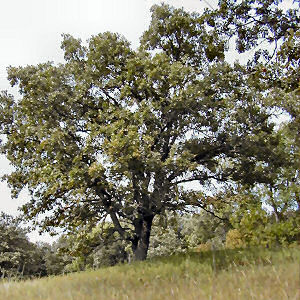
Iowa State Tree: The Oak
The tree shown is a bur oak (Quercus macrocarpa).
On January 23, 1959, House Joint Resolution No. 5, crafted by Iowa State Representative Robert E. Maggert, was introduced in the Iowa General Assembly and referred to the House Agriculture Committee 2.
Except for a petition from twelve citizens in Page County, the path of the bur oak was smooth in committee where, after study, passage was recommended.
On the floor of the house debate was almost non-existent. It seems that Rep. Maggert's strongest statement may have been to note that "We certainly want a state tree for the state bird (wild canary) to roost in." [2]
The bur oak was not supported unanimously however. One representative, from Winterset County, held out for the Delicious apple tree. Two other representatives favored the black walnut. A fourth thought, with some good reason, that the flowering crabapple would be a great choice.
House Joint Resolution No. 5 was easily passed (100-4) by the Iowa House of Representatives on February 10, 1959 and forwarded to the Senate for consideration.
In the Senate the bur oak resolution was presented by Senator Carl H. Ringgenberg.
Things slowed down a little bit in the upper house. But on March 23, House Joint Resolution No. 5 received a favorable opinion from the Judiciary Committee who recommended that the measure be passed.
January 23, 1959.
H.J.R. 5
Agriculture 2.
By MAGGERT, DEN HERDER,
EDGINGTON, SICKELS, STEENHUSEN,
WEIK, ROBINSON, MAULE, KIMBALL,
CUNNINGHAM, (Prentis).A BILL FOR
A Joint Resolution to designate the Bur Oak, quercus macrocarpa, as the official state tree for the state of Iowa.
WHEREAS, many states have not only adopted certain flowers and birds as their state flowers and state birds, but have also adopted certain trees as their state trees, and
WHEREAS, the state of Iowa does not now have an official state tree; now, therefore,
Be It Resolved by the General Assembly of the State of Iowa:
Section 1. The Bur Oak, quercus macrocarpa, is hereby designated and shall hereafter be officially known as the state tree of Iowa.
EXPLANATION OF H. J. R. 5
It is now common for states to have a particular tree designated as the official state tree. Iowa does not now have such a tree and this joint resolution will designate the Bur Oak, quercus macrocarpa, as the state tree of Iowa.
And then progress came to a halt. When the Iowa Legislature adjourned on May 7, 1959, House Joint Resolution No. 5 remained stuck in committee. House Joint Resolution No. 5 was considered dead. It would be two more years before the bur oak would get another shot at the title of official state tree.
The FIFTY-NINTH GENERAL ASSEMBLY
When the Fifty-Ninth Session of the Iowa General Assembly convened on January 9, 1961, efforts to designate an official state tree were underway.
On January 18, 1961, House Joint Resolution No. 10 was introduced. This time it was State Representative Walter R. Hagen who brought a state tree measure before the Iowa House of Representatives and again it was referred to the House Agriculture Committee 2.
But this time, the bur oak was not mentioned. Discussion among the representatives had uncovered differing opinions regarding this official designation as has been noted. It was thought that for this legislative attempt, controversy might be avoided if the proposed state tree did not specify a particular species, but instead allowed for a larger family of popular selections. House Joint Resolution No. 10 simply proposed that "the oak," rather than the bur oak, be named the official state tree of Iowa. In effect any one, or all, of the species of oak tree found in Iowa may be considered the official state tree(s) of the state. Twelve species are native to Iowa.
January 18, 11961.
H.J.R. 10
Agriculture 2.
By HAGEN (Putney).
HOUSE JOINT RESOLUTION
A Joint Resolution to designate "THE OAK" as the official state tree for the state of Iowa.
WHEREAS, many states have not only adopted certain flowers and birds as their state flowers and state birds, but have also adopted certain trees as their state trees, and
WHEREAS, the state of Iowa does not now have an official state tree; now, therefore,
Be It Resolved by the General Assembly of the State of Iowa:
Section 1. "THE OAK" is hereby designated and shall hereafter be officially known as the state tree of Iowa.
EXPLANATION OF H. J. R. 10
It is now common for states to have a particular tree designated as the official state tree. Iowa does not now have such a tree and this joint resolution will designate "The Oak" as the state tree of Iowa.
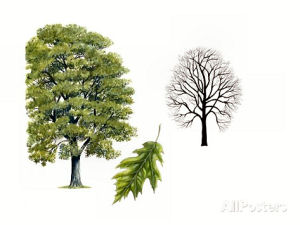
Iowa State Tree: The Oak
The tree shown is a red oak (Quercus rubra)
Photographs, prints and posters
This tactic seemed to be working when House Joint Resolution passed in the House with only one negative vote on February 1, 1961.
Passed in the House, the state tree resolution was off to the Senate where the bur oak resolution had died in the previous session of the legislature.
At least one newspaper, The Evening Journal, Washington, Iowa came up with suggestion from left field; the hickory.
If the oak isn't voted Iowa's state tree, let's consider the hickory. It has helped to make Iowa great. Its sturdy trunk made good wagon tongues. The smoke from its green blocks flavored the hams. And we seem to recall that hickory switches were often used for tanning purposes.
("Editorial Briefs", 1961)
At the moment however, the proposal before the legislature was "the oak." And its current fate was in the hands of the Senate.
On February 28, 1961, Senator Edward A. Wearin, Chairman of the Senate Committee on Iowa Development, reported that the committee recommended that House Joint Resolution No. 10 be passed.
On March 10, 1961, House Joint Resolution No. 10 came to a vote on the floor of the Senate and approved unanimously (47-0).
Three days later, House Joint Resolution No. 10 was sent to the governor for his blessing.
On March 15, 1961, Governor Norman Erbe signed House Joint Resolution No. 10 designating the oak the official state tree of Iowa.
CHAPTER 348
THE OAK AS STATE TREE
H. J. R. 10
A JOINT RESOLUTION to designate "The Oak" as the official state tree for the state of Iowa.
WHEREAS, many states have not only adopted certain flowers and birds as their state flowers and state birds, but have also adopted certain trees as their state trees, and
WHEREAS, the state of Iowa does not now have an official state tree; now, therefore,
Be It Resolved by the General Assembly of the State of Iowa:
SECTION 1. "THE OAK" is hereby designated and shall hereafter be officially known as the state tree of Iowa.
Approved March 13, 1961.
According to the "Iowa Official Register,"
"The Iowa General Assembly chose the oak because it is abundant in the state and serves as shelter, food and nesting cover for many animals and birds. It is difficult to find a tract of natural woodland in Iowa that does not have in it at least one species of oak. No other group of trees is more important to people and wildlife. Acorns, the nuts of oak trees, are a dietary staple of many animals and birds. Deer, wild turkeys, pheasants, quail, wood ducks, raccoons, squirrels, chipmunks, bluejays, nuthatches, grackles and several kinds of woodpeckers are a few of the species that depend on acorns for a significant portion of their diet."
And though only a small percentage of the oak forests remain, the oaks are still one of Iowa's leading commercial timber crops. Oaks are used as construction lumber, railroad ties, fuel, fence posts, mine props, flooring, furniture, ships and boats, tool handles, railroad cars, interior trim, barrels and kegs.
Iowa Law
The oak was adopted as the official state tree of Iowa by House Concurrent Resolution. Therefore, the legislation regarding the official state tree is not recorded in the Iowa Code.
Sources...
A Joint Resolution to Designate the Bur Oak, Quercus Macrocarpa, as the Official State Tree for the State of Iowa., H.R. Res. 5, FIFTY-EIGHTH GENERAL ASSEMBLY of the STATE of IOWA. Iowa State Legislature. Print.
A Joint Resolution to Designate "THE OAK" as the Official State Tree for the State of Iowa., H.R. Res. 10, FIFTY-NINTH GENERAL ASSEMBLY of the STATE of IOWA. Iowa State Legislature. . Print.
[2] "Bur Oak for State Tree." Pella Chronicle 19 Feb. 1959: 6. Print.
"Bur Oak Recommended For Iowa State Tree." Creston News Advertiser 3 Dec. 1958: 1. Print. 14 Nov. 2016.
"Editorial Briefs." The Evening Journal [Washington] 14 Feb. 1961: 7. Print.
"Iowa Billbooks." Iowa State Legislature: Archives. State of Iowa, n.d. Web. 19 Nov. 2016.
"Iowa's Oaks." Trees of Iowa. Iowa State University Forestry Extension, 11 Jan. 2012. Web. 19 Nov. 2016.
JOURNAL OF THE SENATE of the FIFTY-EIGHTH GENERAL ASSEMBLY. Des Moines: State of Iowa, 1960. Print.
JOURNAL OF THE SENATE of the FIFTY-NINTH GENERAL ASSEMBLY. Des Moines: State of Iowa, 1962. Print.
JOURNAL OF THE HOUSE of the FIFTY-EIGHTH GENERAL ASSEMBLY. Des Moines: State of Iowa, 1960. Print.
JOURNAL OF THE HOUSE of the FIFTY-NINTH GENERAL ASSEMBLY. Des Moines: State of Iowa, 1962. Print.
"Maggert Will Vote Against Liquor Poll." Creston News Advertiser 28 Jan. 1959: 2. Print.
"Oak Tree for State?" Ames Daily Tribune 16 Jan. 1961: 16. Print.
[1] "'PLANT AMERICA' PROGRAM." Mason City Globe-Gazette 3 Oct. 1953: 3. Print.
Shearer, Benjamin F. and Barbara S. State Names, Seals, Flags and Symbols: A Historical Guide Third Edition, Revised and Expanded. Westport, Conn: Greenwood Press, 3 Sub edition, 2001.
"Which Tree for Iowa?" The Cedar Rapids Gazette 4 Sept. 1958: 6. Print. 14 Nov. 2016.
Additional Information
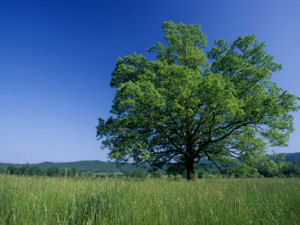
Iowa State Tree: Oak
The oak tree pictured is a bur oak (Quercus macrocarpa)
Photographs, prints and posters
Iowa's Oaks: Iowa State University Forestry Extension coverage if all twelve species of oak tree that are native to Iowa. Note that only the bur oak is found throughout the state..
Field Guide to Native Oak Species of Eastern North America: United States Department of Agriculture (USDA) Forest Service.
Quercus palustris M?nchh. (pin oak): USDA, NRCS. 2016. The PLANTS Database (http://plants.usda.gov). National Plant Data Center, Baton Rouge, LA 70874-4490 USA.
Quercus rubra L. (northern red oak): USDA, NRCS. 2016. The PLANTS Database (http://plants.usda.gov). National Plant Data Center, Baton Rouge, LA 70874-4490 USA.
Quercus imbricaria Michx. (shingle oak): USDA, NRCS. 2016. The PLANTS Database (http://plants.usda.gov). National Plant Data Center, Baton Rouge, LA 70874-4490 USA.
Quercus ellipsoidalis E.J. Hill (northern pin oak): USDA, NRCS. 2016. The PLANTS Database (http://plants.usda.gov). National Plant Data Center, Baton Rouge, LA 70874-4490 USA.
Quercus velutina Lam. (black oak): USDA, NRCS. 2016. The PLANTS Database (http://plants.usda.gov). National Plant Data Center, Baton Rouge, LA 70874-4490 USA.
Quercus marilandica M?nchh.(blackjack oak): USDA, NRCS. 2016. The PLANTS Database (http://plants.usda.gov). National Plant Data Center, Baton Rouge, LA 70874-4490 USA.
Quercus alba L. (white oak): USDA, NRCS. 2016. The PLANTS Database (http://plants.usda.gov). National Plant Data Center, Baton Rouge, LA 70874-4490 USA.
Quercus macrocarpa Michx. (bur oak): USDA, NRCS. 2016. The PLANTS Database (http://plants.usda.gov). National Plant Data Center, Baton Rouge, LA 70874-4490 USA.
Quercus bicolor Willd. (swamp white oak): USDA, NRCS. 2016. The PLANTS Database (http://plants.usda.gov). National Plant Data Center, Baton Rouge, LA 70874-4490 USA.
Quercus muehlenbergii Engelm. (chinquapin oak): USDA, NRCS. 2016. The PLANTS Database (http://plants.usda.gov). National Plant Data Center, Baton Rouge, LA 70874-4490 USA.
Quercus prinoides Willd. (dwarf chinquapin oak): USDA, NRCS. 2016. The PLANTS Database (http://plants.usda.gov). National Plant Data Center, Baton Rouge, LA 70874-4490 USA.
Quercus stellata Wangenh. (post oak): USDA, NRCS. 2016. The PLANTS Database (http://plants.usda.gov). National Plant Data Center, Baton Rouge, LA 70874-4490 USA.
Genus Quercus L. (oak): USDA, NRCS. 2016. The PLANTS Database (http://plants.usda.gov). National Plant Data Center, Baton Rouge, LA 70874-4490 USA.
Quercus L.: Integrated Taxonomic Information System (ITIS).
Quercus L.: Search for images of Quercus L. with Google.
State trees: Complete list of official state trees from NETSTATE.COM.
More symbols & emblems: Complete list of official Iowa state symbols from NETSTATE.COM.
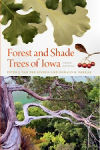
Forest and Shade
Trees of Iowa
Peter van der Linden
Donald Farrar
Forest and Shade Trees of Iowa, by Peter van der Linden and Donald Farrar. 456 pages. Publisher: University Of Iowa Press; 3rd Edition (July 15, 2011)
A complete guide to Iowa?s trees, both native and introduced, full of hundreds of color photos, this new edition of Forest and Shade Trees of Iowa will be immensely useful to arborists, foresters, horticulturists, landscape architects, gardeners, and all Iowans and midwesterners who appreciate the beauty and value of trees and want to learn more about them.
Part 1 of this guide focuses on identification, with user-friendly keys to both summer and winter trees and illustrated descriptions of more than one hundred common species. The trees are arranged according to similarities in foliage; each entry includes a large scan of a leafy branch along with two or three smaller photos of buds, flowers, fruits, and winter twigs. The text contains a description of the species, its geographical distribution, and notes on how to distinguish it from similar species.
Part 2 is divided into conifers and flowering trees and includes all trees native to Iowa, trees that are widely planted, invasive species, some less commonly planted trees, and tall native shrubs that might be mistaken for trees. The authors provide information about the natural history of individual trees, their ecological requirements, pests and diseases that affect them, and their usefulness for such different purposes as windbreaks, landscaping, wildlife plantings, fuel, lumber, and food.
Following these two main parts, three shorter sections describe the planting and care of trees, Iowa?s forest communities, and good places to see trees in the state; a glossary and a bibliography are also included.

